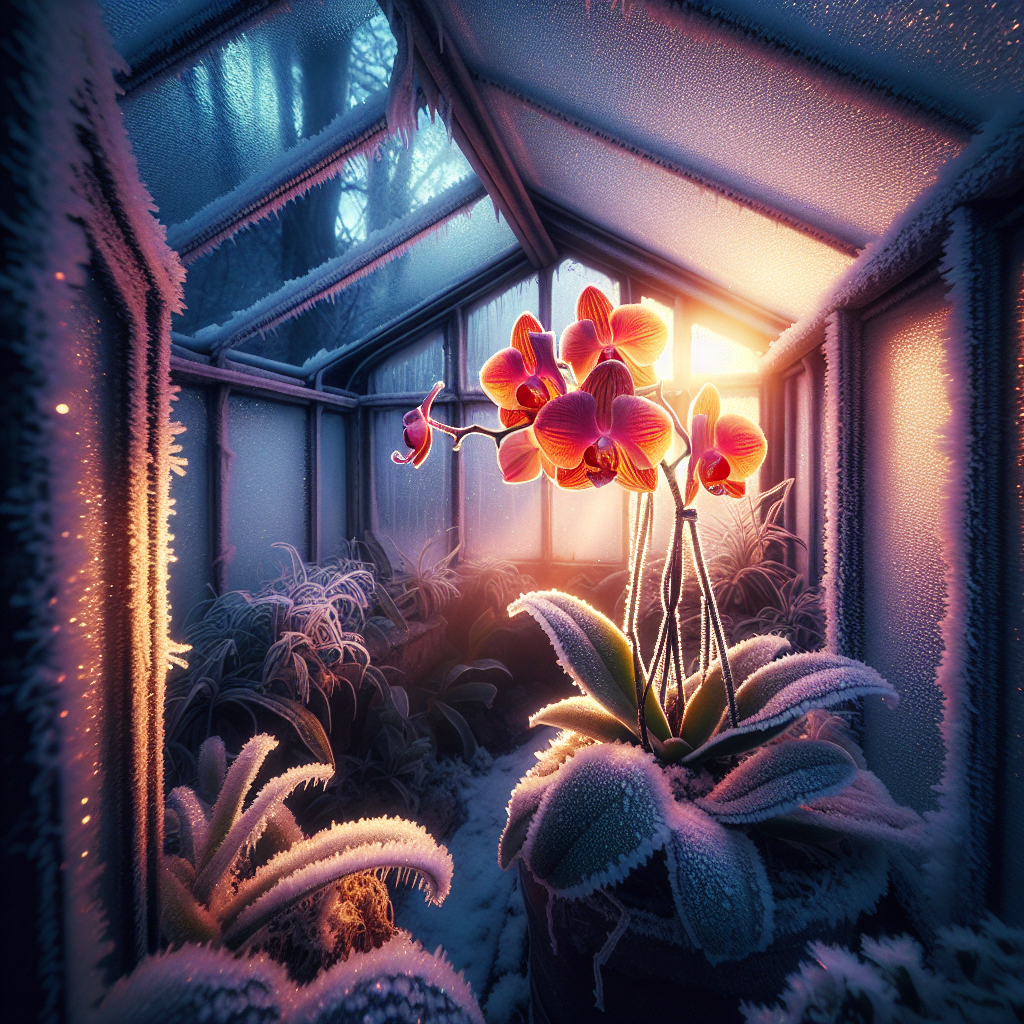
Imagine a world where it’s always summer, even in the depths of winter. Sounds like a dream, right? Well, with the help of winter greenhouses, this dream can become a reality. These fascinating structures provide the perfect environment for exotic plants to thrive year-round, no matter the weather outside. In this article, we will explore the secrets to getting your exotic plants to flourish in winter greenhouses, so get ready to transform your gardening game and bring a touch of the tropics to your backyard oasis.

Choosing the Right Exotic Plants
When it comes to selecting exotic plants for your winter greenhouse, it is crucial to consider their climate requirements. Exotic plants often originate from tropical or subtropical regions, so they may require higher temperatures and humidity levels than what your region typically experiences during winter. Take the time to research the specific climate needs of the plants you are interested in and choose ones that can thrive in the conditions you can provide.
In addition to climate requirements, evaluating the light requirements of exotic plants is equally important. Some plants need direct sunlight, while others prefer shade or filtered light. Consider the location of your greenhouse and the amount and quality of natural light it receives. Supplemental lighting may be necessary to ensure that your exotic plants receive enough light during the short winter days.
Another factor to research when choosing exotic plants is their growth habits. Some plants have vigorous growth and may quickly outgrow their allotted space in a greenhouse. Others may have specialized growth habits, such as climbing or trailing, which may require additional structures or support. Understanding the growth habits of your chosen plants will help you plan and accommodate their needs effectively.
Preparing the Winter Greenhouse
Before winter arrives, it is essential to prepare your greenhouse for the colder months. Proper insulation is crucial to keep the interior temperatures stable and protect your exotic plants from extreme cold. Insulate the walls and roof of your greenhouse using materials such as bubble wrap or double-layered polyethylene film. This will help retain heat and create a more controlled environment for your plants.
In addition to insulation, installing heating systems is necessary to maintain an ideal temperature for your exotic plants. There are various heating options available, such as electric heaters, radiant floor heating, or gas heaters. Choose a heating system suitable for the size and layout of your greenhouse, ensuring that it can adequately heat the space during the coldest winter nights.
Implementing humidity control measures is another important aspect of winter greenhouse preparation. Exotic plants often require higher humidity levels, which may be challenging to maintain during winter when the air tends to be drier. Consider installing humidifiers or misting systems to increase humidity levels. You can also place trays of water or pebbles filled with water around the greenhouse to provide some moisture.
Creating the Ideal Growing Environment
To ensure that your exotic plants thrive throughout the winter season, it is crucial to maintain an optimal temperature within your greenhouse. Monitor the temperature regularly and adjust the heating system as needed to keep it within the desired range for your plants. Generally, most exotic plants prefer temperatures around 60-80°F (15-27°C) during the day and slightly cooler temperatures at night.
In addition to temperature, adequate lighting is essential for the growth and development of exotic plants. If natural light is limited during winter, consider using supplemental lighting options such as fluorescent or LED grow lights. Position the lights at an appropriate distance from the plants to provide sufficient and evenly distributed light.
Another crucial aspect of creating an ideal growing environment is monitoring and adjusting humidity levels. Exotic plants often thrive in higher humidity conditions, but excessive humidity can lead to issues such as fungal diseases. Use a hygrometer to measure the humidity levels within your greenhouse and adjust them accordingly. Misting the plants or using automatic misting systems can help maintain optimal humidity levels.
Optimizing Watering and Drying Practices
Adapting the watering schedule for your exotic plants in the winter is essential to prevent overwatering or underwatering. Since the growth rate of plants slows down during winter, they generally require less frequent watering. However, do not let the soil dry out completely, as this can cause stress to the plants. Regularly check the moisture level of the soil and adjust the watering frequency accordingly.
One of the common mistakes in winter greenhouse care is overwatering. Excessive moisture in the soil can lead to root rot and other fungal diseases. Ensure that your pots have proper drainage holes and use a well-draining potting mix to prevent waterlogging. Additionally, avoid watering during cold periods to prevent the soil from staying excessively wet.
Proper drainage is crucial for maintaining the health of your exotic plants. Ensure that excess water can flow freely out of the pots or containers. You can use saucers or trays under the pots to catch excess water and remove it promptly. Regularly check the drainage and clear any blockages that may impede the flow of water.

Managing Pest and Disease Control
Implementing preventive measures is the best way to manage pests and diseases in your winter greenhouse. Inspect all new plants before bringing them into the greenhouse to ensure they are free from any potential pests or diseases. Quarantine new plants for a short period to monitor them for any signs of infestation or illness before introducing them to the rest of your collection.
Regularly inspecting your plants for pests is key to catching any issues early on. Look for signs of pest activity such as chewed leaves, sticky residue, or webbing. If you notice any signs, immediately isolate the affected plant and take appropriate measures to control the infestation. Regularly clean your greenhouse to remove dead plant material and debris that can harbor pests.
When it comes to pest and disease control, using organic treatments is always preferable. There are various organic insecticides, fungicides, and miticides available that are effective in combating common pests and diseases. Research organic treatment options and choose ones that are safe for your exotic plants and environmentally friendly.
Fertilizing Exotic Plants in Winter
Choosing the right fertilizer type for your exotic plants is crucial for their winter growth. Slow-release fertilizers are often recommended for greenhouse plants as they provide a steady supply of nutrients over an extended period. Look for fertilizers specifically formulated for exotic plants and follow the manufacturer’s instructions for application rates.
Adjusting the fertilization frequency is another factor to consider during winter. Since plant growth slows down in colder temperatures, they require fewer nutrients. Reduce the frequency of fertilizer application but maintain a balanced nutrient supply to ensure your exotic plants receive adequate nourishment. Regularly monitor the plants for signs of nutrient deficiencies or excesses and make adjustments as necessary.
Applying foliar feeding techniques can be beneficial for your exotic plants in winter. Foliar feeding involves applying a liquid fertilizer directly to the leaves, allowing the plants to absorb nutrients more efficiently. Mix a suitable foliar fertilizer and spray it onto the leaves, ensuring thorough coverage. This technique can help alleviate nutrient deficiencies and promote healthy growth during the winter months.
Pruning and Training Methods for Winter Growth
Encouraging compact growth is often desirable for exotic plants in winter, as it reduces the risk of damage from strong winds or heavy snowfall. Regular pruning helps maintain the desired shape and size of your plants. Remove any dead, damaged, or diseased branches to promote overall plant health and prevent the spread of diseases.
When pruning, ensure you use clean and sharp pruning tools to make clean cuts. Make cuts just above a healthy bud or node to encourage new growth in the desired direction. Take care not to prune excessively, as it may stress the plants during the winter months. Observe the growth patterns of each plant and prune accordingly to maintain their shape.
Training techniques can also be employed to guide the growth of your exotic plants during winter. Use stakes, trellises, or wire supports to help vines or climbing plants grow in the desired direction. Regularly check and adjust the supports as the plants grow. Training your plants can also improve air circulation within the greenhouse, reducing the risk of fungal diseases.
Propagating Exotic Plants in the Winter
Winter can be an excellent time to experiment with propagation methods and expand your collection of exotic plants. Different plants have various methods of propagation, such as stem cuttings, leaf cuttings, or division. Research the specific propagation requirements of your chosen plants and choose a method that is suitable for their growth habits.
Creating suitable rooting conditions is crucial for successful propagation. Provide a warm and humid environment for the cuttings or divisions to encourage root growth. Consider using a propagation tray with a clear plastic cover to create a mini greenhouse effect. Use a well-draining rooting medium and maintain consistent moisture levels without overwatering.
Provide necessary care for new plants by monitoring their moisture levels and protecting them from excessive cold or frost. Keep them in a warm and stable environment and gradually acclimate them to the conditions in your winter greenhouse. Once the new plants have established their root systems, you can slowly introduce them to their permanent locations and continue their care accordingly.
Winter Greenhouse Maintenance
Regular cleaning and disinfecting are essential for maintaining a healthy winter greenhouse environment. Remove any fallen leaves, dead plant material, or debris that may harbor pests or diseases. Thoroughly clean all surfaces, including pots, benches, and greenhouse structures, using a mild detergent or disinfectant. This will help prevent the buildup of pathogens and ensure a clean and hygienic environment for your exotic plants.
Inspecting the structural integrity of your winter greenhouse is crucial to identify any potential issues. Check for leaks, drafts, or damaged windows or panels that may compromise the insulation or heating efficiency. Address any issues promptly to maintain a stable environment for your plants. Regularly lubricate hinges or moving parts to ensure smooth operation.
Keeping records of plant performance throughout the winter season will help you track their progress and make informed decisions in the future. Note any changes in growth patterns, flowering, or pest and disease issues. This information will be valuable for adjusting your greenhouse maintenance practices and care routines for the next winter season.
Seeking Professional Guidance and Support
If you encounter challenges or have specific questions about caring for your exotic plants in the winter greenhouse, do not hesitate to seek professional guidance. Consult with horticultural experts who have knowledge and experience with exotic plants. They can provide personalized advice and recommendations tailored to your specific plants and growing conditions.
Joining greenhouse communities or online forums is an excellent way to connect with other plant enthusiasts who share your passion for exotic plants. These communities often offer valuable insights, tips, and troubleshooting advice. Engage in discussions, ask questions, and share your experiences to learn from others and expand your knowledge.
Attending workshops and conferences related to greenhouse gardening can be enlightening and inspiring. These events often feature experts who present on various topics, including winter greenhouse care. Take advantage of these opportunities to learn from industry professionals, network with like-minded individuals, and stay updated on the latest trends and advancements in exotic plant care.
By following these comprehensive steps and putting in the necessary effort, you can create an ideal environment for your exotic plants in your winter greenhouse. With proper care, attention to detail, and a little bit of experimentation, your exotic plants will not only survive but thrive throughout the winter season, bringing beauty and warmth to your indoor sanctuary. Happy greenhouse gardening!

